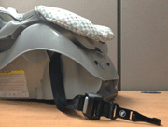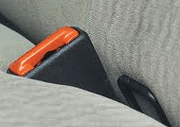The proper use of car seats and boosters is required by law.
This is a general guide only. Always follow the manufacturer’s instructions and vehicle owner’s manual.
Learn How Injuries Occur as Children Grow
- Infants and children have large heads in proportion to the rest of their body.
- The muscles in their neck are not well developed.
- In a head-on collision, a child’s head can jerk forward suddenly and violently, causing neck and spinal injuries.
- Due to a child’s smaller size, an adult seat belt cannot be positioned on the parts of a child’s body that are strongest to withstand the force of a crash.
- A child’s body can easily slip through an adult seat belt system.
- Use your child’s height, weight, age and developmental stage to determine if your child is ready to move to the next stage of car seat.
Watch Children Closely
- Keep car keys out of reach and sight of children.
- Never leave your child alone in a car under any circumstances, even sleeping infants.
- If your child gets locked inside a car – call 911.
Create Safer Places for Children
- Protect your child with a proper car seat that is correctly installed.
- Keep children in each stage for longer and in a seat that fits them. When switching to the next stage of child care seat, check that the child meets all the minimum requirements outlined by the manufacturer.
- Check the temperature of your child’s car seat surface and safety belt buckles before placing your child in the car seat.
- Car seats should be thrown out if they:
- Have passed their expiry date.
- Have been in a crash (even minor).
- Have cracks, chips, frayed harness or missing parts.
- If you throw out a car seat, be sure to cut off the harness straps so that nobody can use the seat.
- Only use car seats in cars and strollers designed to hold car seats. Any other use of a car seat can change the child’s position and increase the risk of tipping, strangulation, or death from pressure on the child’s neck.
- Car seats are designed for safe travel, not for sleep. Move your baby to a safe sleep space, such as a cradle, bassinet, or crib when you arrive at your destination even if your baby is sleeping soundly.
- Place car seats on the floor only. Placing it on a higher level increases the risk of it falling even from a child making small movements.
- In colder temperatures, it is safest to use a blanket over your baby’s legs and torso. Thick and/or puffy winter jackets, and extra padding between your baby and the seat, or your baby and the harness straps straps interferes with the car seat straps from sitting securely and properly against the child’s body.
- Avoid seat belt adjusters as they may not be safety regulated.
Create and Follow Family Safety Rules
- Make family safety rules with your children.
- Help them understand why rules are important and always need to be followed.
- Teach children not to play in, or around a vehicle.
- Always wear a seat belt when your ride in a vehicle.
- Be a role model. Follow Ontario's Child Passenger Seat Requirements because children learn by watching you.
Installing Car Seats
Did you know that 4 out of 5 car seats are improperly installed? These are the most common mistakes:
- Car seat is not right for the child’s weight and height.
- Vehicle seat belt is not tight enough to secure car seat properly.
- Harness or shoulder straps are too loose.
- Tether strap is not used or used incorrectly.
- Locking clip is not used when required.
For all child car seats, always follow the manufacturer’s instruction manual and your vehicle owner manual for proper use and installation.
Types of Car Seats
There are four car-seat stages that protect your child as they grow
- Rear-facing
- Forward-facing
- Booster seat
- Seatbelt
Each type of car seat is different- some car seat fit more than one stage. Choose one that is right for your child’s height, weight, age and developmental stage, and has the National Safety Mark label attached to the seat (round sticker with maple leaf).
Keep your child in each stage for as long as they fit within the height and weight ranges specified by the manufacturer.
Stage 1: Rear-Facing Seat
- Infants and young children should ride in a rear-facing seat, either in an infant seat with a detachable base, or in a convertible seat.
- Rear-facing car seat provides the best protection for your child’s head, neck and spine in a sudden stop or crash
- Keep rear-facing for as long as possible – to maximum height/weight limit of your car seat.
- Always place in the back seat of the vehicle away from active airbags and rear-facing. Use the appropriate recline level set out by the manufacturer.
- Ensure base of car seat attaches and is anchored properly to the vehicle seat.
- Pull anchoring belt tight so that the car seat moves no more than 2.5 cm (1 inch) forward or sideways.
- Harness straps must lay flat and snug so no excess strap can be pinched at the collarbone. Harness straps must be at or slightly below the shoulder.
- Move chest clip to armpit level.
- Place carrying handle in position recommended by manufacturer.
Stage 2: Forward-Facing
- Minimum requirement by law: use when child is over one year of age, over 10 kg (22 lbs) and walking without help.
- Uses a five-point harness to spread the force of a sudden stop or crash over the strongest parts of your child’s body.
- By law, attach tether strap to tether anchor in the car to reduce head and neck injuries in a crash.
- Pull seat belt anchor strap tight so that car seat moves no more than 2.5 cm (1 inch) forward or sideways.
- Place harness straps at or above shoulder.
- Some car seats are available up to 29.5 kg (65 lbs). Keep your child in a forward-facing car seat until they weight at least 18kg (40kg) and is able to sit correctly in a booster seat.
Stage 3: Booster Seats
- Use booster seats when your child is at least 19kg (40 lbs). Ensure your child is able to sit straight and tall for the whole ride, without moving around or unbuckling.
- A booster seat helps position the vehicle seat belt to fit safely across their strongest bones and away from their soft belly
- Ensure lap belt is low across the hips.
- Ensure shoulder belt lies flat across the chest.
- A no back booster seat can only be used when the middle of the child’s ear is not above the back of the vehicle seat or head rest.
- Keep using the booster seat until your child is at least 145 cm (4 feet 9 inches) tall and fit the adult seat belt correctly.
Stage 4: Seat Belts
- The adult seat belt must fit properly over the child’s strongest bones to protect the child.
- Transition into seat belts when child has outgrown their booster seats. Once a child is taller than 145 cm (4 feet 9 inches) they may begin to safely fit into the adult seat belt.
- Children should keep using booster seats if the seat belt does not fit snuggly on their lap and centered on their shoulder
Installation Parts
Universal Anchorage System (UAS)
- Vehicles made after 2022 are equipped with a UAS, and therefore have lower anchor bars. This makes it easier to correctly install car seats.
- If car does not have UAS, use the vehicle seat belt to hold car seat in place correctly.
- UAS system only works for children up to 40 lbs. Use the seat belt for children over 40 lbs.
Tether Strap
- A tether strap is required by law for forward-facing car seats, it is a strap with a hook hanging on the back, at the top of your child car seat, designed to attach to one of the vehicle’s tether anchors.
- A tether strap prevents the car seat from tipping forward in a collision, which limits the forward head movement and reduces the risk of the child’s head from hitting the back of the seat in front of them.
- Consult your vehicle and car seat manual to find the tether strap and anchor, and for specific installation instructions.

Provincial Law
Provincial Law
Ontario’s Highway Traffic Act
The Ontario's Highway Traffic Act requires anyone transporting children under the age of eight, to correctly secure them in an appropriate child restraint system according to the child’s age, height and weight. This applies to all caregivers, including babysitters and grandparents.
This law states that a child can start using an adult seat belt once they meet any one of the following:
- Child turns eight years old.
- Child weighs 36kg (80lbs).
- Child is 145 cm (4 feet, 9 inches) tall.
The Ontario’s Highway Traffic Act exempts taxicabs, buses or public vehicles transporting passengers for hire from the legal requirements of child car seats and booster seats. Ride-sharing services such as Uber and Lyft are not considered public transportation in Ontario. Therefore, children under the age of eight years need to be properly secured in the correct child car seat or booster seat. Failure to do so can result in fines and penalties.
More Information
- Parachute Canada – National organization dedicated to injury prevention, including car seat safety.
- Transport Canada – Federal government car seat safety information including installation, recall notices, safety and testing information.
- Ministry of Transportation of Ontario – Provincial government car seat safety information including installation, fines and recall notices.




